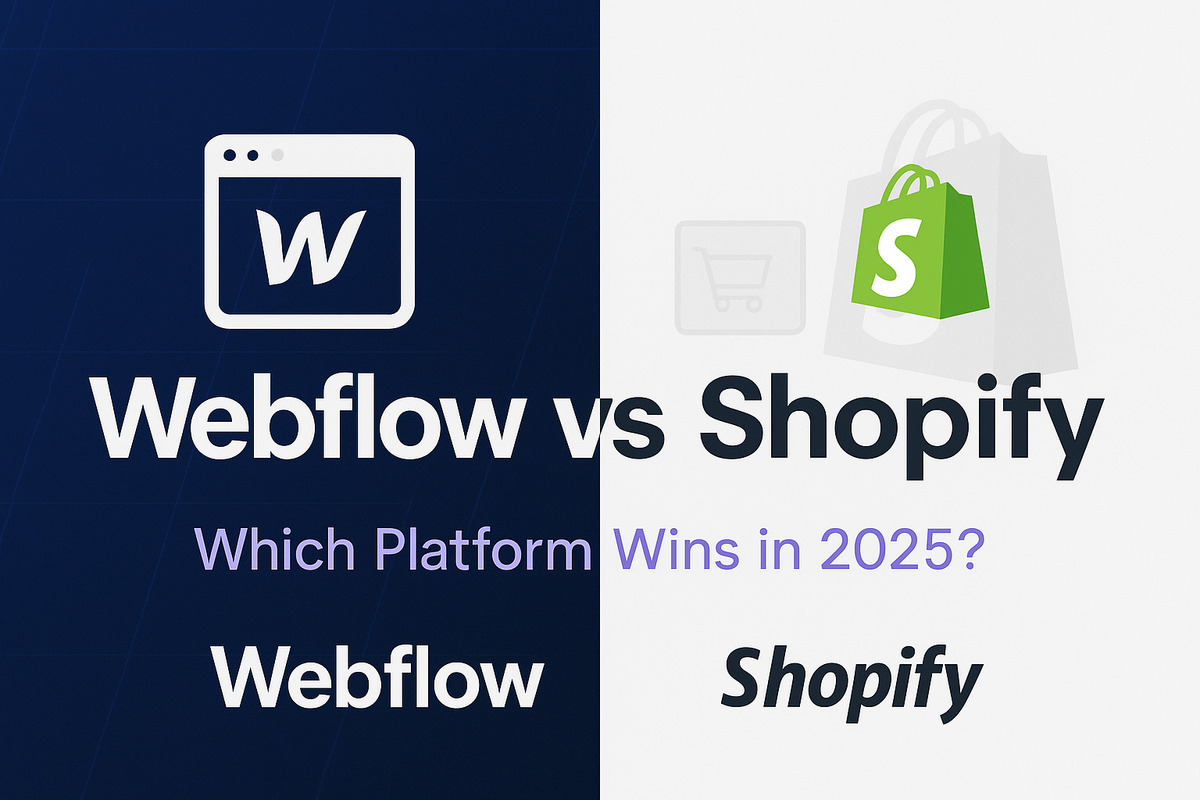Webflow vs Shopify: Which Platform Should You Choose in 2025?
Compare Webflow vs Shopify in 2025: Discover which platform is better for design control, ecommerce scaling, SEO, and client work—plus when to combine both for the best results.

If you're building a website or online store in 2025, you're likely choosing between Webflow and Shopify. This comparison explores their core differences, strengths, limitations, and ideal use cases—helping you pick the best platform for your goals.
TL;DR: Which One Wins?
- Choose Shopify if you need a powerful ecommerce engine, omnichannel selling, and scalability.
- Choose Webflow if design flexibility, advanced CMS features, and total control over branding matter more than native ecommerce power.
- Combine Both (via tools like Wized or Shopyflow) if you want full control of Webflow’s design with Shopify’s robust backend.
What Is Webflow?
Webflow is a visual website builder and CMS platform that gives designers, marketers, and developers full control over a site’s look and structure—without writing code.
Key Features
- Visual design freedom with CSS Grid, Flexbox, and animations.
- Powerful CMS for blogs, portfolios, or content-heavy pages.
- SEO-friendly with control over tags, structure, schema, and page speed.
- Fast hosting via CDN with scalable infrastructure.
- Integrations with apps, analytics tools, and even Shopify.
What Is Shopify?
Shopify is an all-in-one ecommerce platform built for selling products online and offline. It handles everything from inventory to checkout, payments, marketing, and fulfillment.
Key Features
- Robust ecommerce tools from product catalogs to cart recovery.
- Built-in payment processing (Shopify Payments) and fraud protection.
- App store with 6,000+ tools for marketing, shipping, reviews, and more.
- Point-of-sale (POS) for physical retail locations.
- Omnichannel selling on Facebook, Instagram, Amazon, and more.
Webflow vs Shopify: Side-by-Side Comparison
| Feature | Webflow | Shopify |
|---|---|---|
| Purpose | Website builder & CMS | All-in-one ecommerce platform |
| Design Flexibility | Full visual control | Template-based, limited customization |
| Ecommerce Strength | Basic built-in features | Advanced tools and scaling built-in |
| Learning Curve | Steep, powerful | Beginner-friendly |
| CMS & Content Tools | Advanced CMS, great for blogs | Limited, outdated blog editor |
| App Ecosystem | Moderate, growing | 6,000+ apps |
| SEO | Strong technical control | SEO-friendly but less granular |
| Product Limitations | Max 3,000 products | Unlimited products |
| Pricing Flexibility | Free to start, lower tier costs | More features, but app costs add up |
When to Choose Webflow
Webflow is ideal if you:
- Want a visually stunning site with pixel-level control
- Need a custom CMS-driven blog, resource hub, or portfolio
- Are building for clients or running an agency
- Care more about content and branding than ecommerce
Example:
A digital agency built a landing page system with Webflow, reducing dev cycles by 70%, boosting page speed, and publishing new content 4x faster.
Explore why agencies love Webflow
When to Choose Shopify
Shopify is your best bet if you:
- Sell physical or digital products
- Need integrated checkout, payment, and inventory tools
- Want access to a massive app ecosystem
- Plan to scale into retail, wholesale, or global markets
Example:
A small brand selling handmade goods scaled to 7 figures using Shopify’s built-in checkout, email marketing, and multichannel sales tools.
Learn how to convert visitors into buyers
Combine Webflow + Shopify
Want design control and ecommerce scale? Webflow and Shopify can be combined to get the best of both worlds. Many brands now run Shopify as a backend and Webflow as the frontend using:
It’s more technical and pricier—but offers the best of both worlds.
FAQs
What’s the main difference between Webflow and Shopify?
Webflow focuses on site design and CMS control. Shopify focuses on ecommerce infrastructure and selling.
Can Webflow handle ecommerce?
Yes, but only basic stores. Its ecommerce tools are best for micro-shops or product catalogs—not full-scale operations.
Can you integrate Webflow and Shopify?
Yes, using tools like Wized or Udesly, you can use Webflow as the visual frontend and Shopify as the ecommerce backend.
Which platform is better for SEO?
Webflow offers more granular SEO control, but both platforms are SEO-capable.
Which platform is cheaper?
Webflow has a free tier and cheaper top plans. Shopify includes more features but can become more expensive due to app subscriptions and transaction fees.
Which Platform Is Best?
| If you… | Go With… |
|---|---|
| Want to sell products online at scale | Shopify |
| Need full control over design & branding | Webflow |
| Want the best of both worlds | Use Both |
Continue Learning with Unkoa
For more insights on converting site traffic and improving your funnel, check out the Convert Visitors hub.
If you're building for clients, don't miss The Ultimate Guide to Getting Clients for Your Agency—packed with strategies to land leads using Webflow, Shopify, and other scalable tools.
Browse more articles at Unkoa or follow along on @unkoamarketing.





